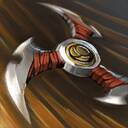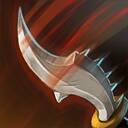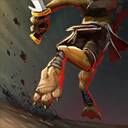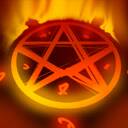The One Who Shoots First - Bounty Hunter
By KawaiiSocks on
It is not uncommon for certain heroes to stay relevant despite significant nerfs. Their core concept allows them to be effective in almost any environment, and  Bounty Hunter is one of such heroes. He has been a viable professional pick for almost a year now, and the trend is unlikely to change—at this point, any simple number tweaking would have little effect.
Bounty Hunter is one of such heroes. He has been a viable professional pick for almost a year now, and the trend is unlikely to change—at this point, any simple number tweaking would have little effect.
Originally played as an offlane, DPS hero,  Bounty Hunter has since transformed into a heavy utility one. His early game consists of roaming the map and finding pickoffs, where later he becomes a vision and economy booster for his team. More often than not, he boosts the economy of his team, while also forcing the enemy team to spend more resources on detection, leading to a very unfair macro game. We’ll discuss the hero’s position in the meta and look over the more optimal builds for the hero.
Bounty Hunter has since transformed into a heavy utility one. His early game consists of roaming the map and finding pickoffs, where later he becomes a vision and economy booster for his team. More often than not, he boosts the economy of his team, while also forcing the enemy team to spend more resources on detection, leading to a very unfair macro game. We’ll discuss the hero’s position in the meta and look over the more optimal builds for the hero.
Meta Data

Perhaps more than any other hero in the game,  Bounty Hunter rewards skill. His win rate is a constant progression from the lower brackets, with an almost 10% difference between 2k and 5k+ games. The only other hero who comes close to this “skill/reward” ratio is
Bounty Hunter rewards skill. His win rate is a constant progression from the lower brackets, with an almost 10% difference between 2k and 5k+ games. The only other hero who comes close to this “skill/reward” ratio is  Earth Spirit.
Earth Spirit.
Unlike  Earth Spirit, however, the complexity of Bounty Hunter comes from better understanding of the game momentum and tempo, rather than from the ability to correctly land skillshots. Reading the map is an integral part of playing the hero—there is a hint of luck involved in it, but otherwise it is a trainable skill that can be developed.
Earth Spirit, however, the complexity of Bounty Hunter comes from better understanding of the game momentum and tempo, rather than from the ability to correctly land skillshots. Reading the map is an integral part of playing the hero—there is a hint of luck involved in it, but otherwise it is a trainable skill that can be developed.
The pick rate of the hero is also rather impressive when it comes to the higher brackets—he is in 40% of 5k+ games and the 11th most popular hero in the game. This popularity can be attributed to both the effectiveness of the hero and his appeal from the “fun-to-play” perspective. He is also rather independent in the earlier stages and fits most lineups exceptionally well, as long as they can afford a roamer.
Skill Build
Ever since the 6.84 changes to  Shuriken Toss scaling, the skill build progression for the hero has become a lot clearer. If previously extra points in it would provide +100/+100/+50/+75 DMG, it is now a much more logical progression of +75 increments. The damage on it has also been substantially increased, capping out at 375 at max level. Hence, the skill is generally maxed out first.
Shuriken Toss scaling, the skill build progression for the hero has become a lot clearer. If previously extra points in it would provide +100/+100/+50/+75 DMG, it is now a much more logical progression of +75 increments. The damage on it has also been substantially increased, capping out at 375 at max level. Hence, the skill is generally maxed out first.
The added scaling to the  Jinada is a nice touch, however the MS slow aspect of it increases in 3% increments, and it is generally not worth it in the early game, past the value point. Similarly, cooldown reduction does very little in surgical pickoffs the hero is known for. There is an option to go for a second level against heroes with naturally high MS (e.g.
Jinada is a nice touch, however the MS slow aspect of it increases in 3% increments, and it is generally not worth it in the early game, past the value point. Similarly, cooldown reduction does very little in surgical pickoffs the hero is known for. There is an option to go for a second level against heroes with naturally high MS (e.g.  Luna,
Luna,  Chaos Knight,
Chaos Knight,  Enchantress etc.), but it is generally not worth it.
Enchantress etc.), but it is generally not worth it.
The return on damage as well as the duration increase for extra levels in  Shadow Walk is generally a better deal, compared to Jinada. Not only does it increase the burst damage in the earlier levels, but also allows for mana conservation—longer duration means one needs to use the spell less to stay invisible. The fade time reduction is also a very nice touch against high burst heroes and does come up surprisingly often. Due to his nature,
Shadow Walk is generally a better deal, compared to Jinada. Not only does it increase the burst damage in the earlier levels, but also allows for mana conservation—longer duration means one needs to use the spell less to stay invisible. The fade time reduction is also a very nice touch against high burst heroes and does come up surprisingly often. Due to his nature,  Bounty Hunter in the mid-game is a very expensive hero to lose and not dying is almost as important as getting kills on the hero.
Bounty Hunter in the mid-game is a very expensive hero to lose and not dying is almost as important as getting kills on the hero.
Finally,  Track is taken whenever it is possible—the amount of utility and economy boost from it is unparalleled. This spell should be spammed, since it costs relatively little mana and offers crucial vision for both teamfights and macro-game. It also gives information on the current gold of the tracked hero, something that is utilized far less than it should. Disrupting item timings and catching the enemy cores without buyback gold is a rather underrated bonus, which allows for better decision making and easier courier snipes.
Track is taken whenever it is possible—the amount of utility and economy boost from it is unparalleled. This spell should be spammed, since it costs relatively little mana and offers crucial vision for both teamfights and macro-game. It also gives information on the current gold of the tracked hero, something that is utilized far less than it should. Disrupting item timings and catching the enemy cores without buyback gold is a rather underrated bonus, which allows for better decision making and easier courier snipes.
Item Build
Currently, there are two types of Bounty Hunter players—the ones who have fully embraced the utility role of the hero and the ones who are building the hero as a damage dealer. While the first option is generally seen as a more effective one, the latter is not completely awful, unless Bounty Hunter starts going for  Battle Fury.
Battle Fury.
The utility build concentrates on getting a lot done in the earlier stages and a smooth transition into mid-game.  Arcane Boots is a huge enabler in this scenario, since it increases the hero’s sustainability as well as any lane he chooses to gank. It also allows for multiple Shurikens even within a single fight. Given the mana cost increase on it, this item is more or less a must on Bounty Hunter.
Arcane Boots is a huge enabler in this scenario, since it increases the hero’s sustainability as well as any lane he chooses to gank. It also allows for multiple Shurikens even within a single fight. Given the mana cost increase on it, this item is more or less a must on Bounty Hunter.
Early Game
 Mekansm is often praised for what it does, but it is rare for supports to get it in a timely manner. Moreover, supports are generally easily focused down without the possibility of using Mekansm at all or forced to use it too early giving only partial benefit. It is not the case with Bounty Hunter, however, since he can get it very early and generally doesn’t need to stay close to the enemy in a fight—the Track/Shuriken bounces allow for extremely flexible positioning.
Mekansm is often praised for what it does, but it is rare for supports to get it in a timely manner. Moreover, supports are generally easily focused down without the possibility of using Mekansm at all or forced to use it too early giving only partial benefit. It is not the case with Bounty Hunter, however, since he can get it very early and generally doesn’t need to stay close to the enemy in a fight—the Track/Shuriken bounces allow for extremely flexible positioning.
 Urn of Shadows is a great sustain booster and a decent offensive tool. More often than not, it is built instead of Mekansm, if there is a more natural carrier for it in the team or if the early game did not go well for Bounty Hunter. Overall, while having one Urn in the team is never a bad thing, the item should not be considered core by any means.
Urn of Shadows is a great sustain booster and a decent offensive tool. More often than not, it is built instead of Mekansm, if there is a more natural carrier for it in the team or if the early game did not go well for Bounty Hunter. Overall, while having one Urn in the team is never a bad thing, the item should not be considered core by any means.
Mid Game
If the previous items can be considered more or less staples on the hero, come mid game the item selection becomes very situational.
 Guardian Greaves is an amazing item since it allows to conserve item slots and provides a very strong aura. However, more often than not it is not worth extra 1650 gold. It will be generally built at later stages, but unless there are some strong debuffs on the enemy team, the item can be delayed.
Guardian Greaves is an amazing item since it allows to conserve item slots and provides a very strong aura. However, more often than not it is not worth extra 1650 gold. It will be generally built at later stages, but unless there are some strong debuffs on the enemy team, the item can be delayed.
 Force Staff is the king of positioning and saving teammates. Against any melee core, it becomes a nuisance they have to deal with on a constant basis. Strong single-target focus heroes such as
Force Staff is the king of positioning and saving teammates. Against any melee core, it becomes a nuisance they have to deal with on a constant basis. Strong single-target focus heroes such as  Beastmaster and
Beastmaster and  Bane will also suffer a substantial hit to their utility. Moreover, having this item against heroes with strong slow effects cannot be underrated. The counter-play mechanic built into the force-staff is simple, yet has almost unlimited scenarios when it is useful.
Bane will also suffer a substantial hit to their utility. Moreover, having this item against heroes with strong slow effects cannot be underrated. The counter-play mechanic built into the force-staff is simple, yet has almost unlimited scenarios when it is useful.
 Blink Dagger can be considered a more aggressive alternative to the
Blink Dagger can be considered a more aggressive alternative to the  Force Staff. It doesn’t save teammates, but the scouting potential it opens up is almost unparalleled. Staying safe while continuously harassing the enemy with Track has a strong effect on the vision your team has and forces them to play more conservatively, which will give your team a macro economic advantage without direct confrontation.
Force Staff. It doesn’t save teammates, but the scouting potential it opens up is almost unparalleled. Staying safe while continuously harassing the enemy with Track has a strong effect on the vision your team has and forces them to play more conservatively, which will give your team a macro economic advantage without direct confrontation.
 Medallion of Courage and
Medallion of Courage and  Solar Crest are strong early-game counters to heavy-hitting cores such as
Solar Crest are strong early-game counters to heavy-hitting cores such as  Drow Ranger and
Drow Ranger and  Sven. It can decide the outcome of the game in these earlier stages before the enemy gets their BKBs and as such should not be underrated. It is also a very strong tool for Roshan killing—having this item will shave off a substantial amount of time from getting the
Sven. It can decide the outcome of the game in these earlier stages before the enemy gets their BKBs and as such should not be underrated. It is also a very strong tool for Roshan killing—having this item will shave off a substantial amount of time from getting the  Aegis of the Immortal
Aegis of the Immortal
 Pipe of Insight is a rather forgotten item, but its utility against magic-heavy lineups is unparalleled. Since 6.84 it also provides a 10% magic resistance aura. The effect of this aura is not clearly visible, however on tankier heroes it can make a huge difference. The Barrier active is also handy when breaching high-ground against teams with strong outpush potential—at the very least it will allow your creepwave to reach the enemy base and disable the backdoor for 15 seconds.
Pipe of Insight is a rather forgotten item, but its utility against magic-heavy lineups is unparalleled. Since 6.84 it also provides a 10% magic resistance aura. The effect of this aura is not clearly visible, however on tankier heroes it can make a huge difference. The Barrier active is also handy when breaching high-ground against teams with strong outpush potential—at the very least it will allow your creepwave to reach the enemy base and disable the backdoor for 15 seconds.
 Crimson Guard is a highly situational pick on
Crimson Guard is a highly situational pick on  Bounty Hunter, but its active effect can become a necessity for your team when facing heroes like
Bounty Hunter, but its active effect can become a necessity for your team when facing heroes like  Windranger. More often than not it will not be the optimal choice, but it is still necessary to give it some consideration. High AS/low DMG heroes can be rendered almost completely useless for a big portion of the game.
Windranger. More often than not it will not be the optimal choice, but it is still necessary to give it some consideration. High AS/low DMG heroes can be rendered almost completely useless for a big portion of the game.
 Vladmir's Offering is a cheaper, more versatile alternative to Crimson Guard. Straight up armor increase will generally scale better with your teammates’ HP, while lifesteal and mana regeneration Aura will allow for better sustain.
Vladmir's Offering is a cheaper, more versatile alternative to Crimson Guard. Straight up armor increase will generally scale better with your teammates’ HP, while lifesteal and mana regeneration Aura will allow for better sustain.
Late-game
 Lotus Orb and
Lotus Orb and  Linken's Sphere are the reactive and proactive items against strong single-target lineups. The former allows for hex/silence dispels, while potentially protecting the target from further focus. The latter is better against the stronger disables, such as
Linken's Sphere are the reactive and proactive items against strong single-target lineups. The former allows for hex/silence dispels, while potentially protecting the target from further focus. The latter is better against the stronger disables, such as  Doom or
Doom or  Primal Roar, since it will generally give your teammate some time to react. Both items are great in their own right, and it is not a bad idea to have both of them available in certain scenarios.
Primal Roar, since it will generally give your teammate some time to react. Both items are great in their own right, and it is not a bad idea to have both of them available in certain scenarios.
 Diffusal Blade is a highly effective dispel which can work wonders when used both on teammates and enemies. It is ill-advised to use it as a generic slow, however against heroes like
Diffusal Blade is a highly effective dispel which can work wonders when used both on teammates and enemies. It is ill-advised to use it as a generic slow, however against heroes like  Omniknight it can be the game-winning item on its own. Being extremely stingy with the charges is a necessity—getting this item on Bounty Hunter is almost always strictly a utility play and it gives very little without the active component.
Omniknight it can be the game-winning item on its own. Being extremely stingy with the charges is a necessity—getting this item on Bounty Hunter is almost always strictly a utility play and it gives very little without the active component.
 Scythe of Vyse and
Scythe of Vyse and  Abyssal Blade are the items no team can have an abundance of. Extremely expensive, they both offer a strong disable which can compensate for lack of DPS in the late game and allow for strong teamfight potential. The first option is arguably better, since it has a longer cast range and duration, however the latter can be a necessity against heavy magic immunity lineups.
Abyssal Blade are the items no team can have an abundance of. Extremely expensive, they both offer a strong disable which can compensate for lack of DPS in the late game and allow for strong teamfight potential. The first option is arguably better, since it has a longer cast range and duration, however the latter can be a necessity against heavy magic immunity lineups.
 Dagon and
Dagon and  Ethereal Blade are the finishing touches on utility Bounty Hunter. Both of these items provide incredible burst damage and sometimes they are the missing pieces to tip the scales. There is also an option to rush these items, however it is a much riskier build.
Ethereal Blade are the finishing touches on utility Bounty Hunter. Both of these items provide incredible burst damage and sometimes they are the missing pieces to tip the scales. There is also an option to rush these items, however it is a much riskier build.
 Assault Cuirass and
Assault Cuirass and  Shiva's Guard are the last in this list for a reason—these items, while decent on Bounty Hunter are generally better built on other heroes. If there are no natural carriers for either it is acceptable to build a strong late-game aura on BH, however a full return on investment is unlikely.
Shiva's Guard are the last in this list for a reason—these items, while decent on Bounty Hunter are generally better built on other heroes. If there are no natural carriers for either it is acceptable to build a strong late-game aura on BH, however a full return on investment is unlikely.
DPS build
There are two distinct DPS builds—previously discussed Dagon+Ethereal blade rush and the right-clicking one.
The right-click Bounty Hunter suffers from a lack of reliable gap closers on the hero—invisibility simply won't cut it against any team even in the lower brackets. It is also riskier to build the hero as a DPS machine, since it will undoubtedly leave less resources on the map for your teammates.
Otherwise, the item progression is rather simple— Phase Boots into a strong tempo play in the form of
Phase Boots into a strong tempo play in the form of  Desolator is generally the most popular option. It is often followed up by BKB and more DPS items afterwards. A Rapier Crit is something the enemy team will have to take into account, yet again, it is a high risk-moderate rewards playstyle.
Desolator is generally the most popular option. It is often followed up by BKB and more DPS items afterwards. A Rapier Crit is something the enemy team will have to take into account, yet again, it is a high risk-moderate rewards playstyle.
Dealing with Bounty Hunter
When facing Bounty Hunter it is necessary to understand that he is both a micro and macro heavy hero. Not only is he capable of creating an opening for the enemy team to net a kill, but he will also leech resources from the supports. Finding balance between being stingy and being effective with the detection is a must.
More often than not, he forces the enemy team to play reactively— Sentry Ward is a better alternative to
Sentry Ward is a better alternative to  Dust of Appearance. The former should be primarily used to ensure safety first and foremost. Spending an extra ward for a chance of a kill on Bounty Hunter is sometimes not worth it—use them only if the kill is guaranteed. Due to his roaming nature, he is frequently underleveled in the early game, and the chance to kill him is unlikely to net enough gold to justify the costs.
Dust of Appearance. The former should be primarily used to ensure safety first and foremost. Spending an extra ward for a chance of a kill on Bounty Hunter is sometimes not worth it—use them only if the kill is guaranteed. Due to his roaming nature, he is frequently underleveled in the early game, and the chance to kill him is unlikely to net enough gold to justify the costs.
If the opposing team plays correctly in the early game, the hero will remain heavily underleveled and will fall off hard in the mid-game. Without the ability to snowball out of control he can quickly become a non-factor. He will generally be able to come back with the track kills later on, but it might be too late.
It is also necessary to understand that high risk plays are not worth it against Bounty Hunter—even trades will put the team with BH in an advantage. Careful approach to the game is advised—staying in groups and having vision on the rest of the enemy team is a good tactic in most games, but even more so against BH.
Final Thoughts
Bounty Hunter is an extremely rewarding hero. It tells a lot about him that he is among the few heroes which have a continuous growth in win rate across skill brackets. Unlike many other heroes who show similar trends, such as ( Invoker and
Invoker and  Earth Spirit), his complexity does not come from personal mechanical skill, but rather from the ability to understand Dota on a more strategic level.
Earth Spirit), his complexity does not come from personal mechanical skill, but rather from the ability to understand Dota on a more strategic level.
As such, the hero is highly recommended to more methodical players, who might not have time to train extensively to achieve the high efficiency of mechanical players. Older, more experienced players might find this hero to be highly effective in their hands—after all Dota is a strategy game first and an action game second.
Copyright 2024 Elo Entertainment Inc.. Мы нанимаем! Dota 2 is a registered trademark of Valve Corporation.
Bounty Hunters who build Battlefury deso and crits are the worst scum of the earth.
I wish that these articles that contain some good info wouldn't go off on some tangent. Who cares if people build aghs on him, just focus on the play style you want to highlight.
Also the pick rate goes up because people that don't know how to pull and hate buying wards can pick him in any game that they don't get a core position and do almost nothing and have a higher than 50% win rate.
You say random things that aren't factually true, like that no numbers changes can make him irrelevant etc. just stick to the content and not your opinions on random shit.
"Strategy first action second" I mean I agree but that claim is largely baseless and not relevant.
Out of all the comments, only one noticed that you didn't mention that Greaves PURGES dust. Which is huge in terms of playstyle and ability to be on the face of people slowing and shuriken-ing them.
Graves is amazing to "rush", as in get it as fast as possible, because of this fact alone.
I have almost 100 bh games ranging 4K MMR and utility aura "playmaker" bountyhunter is by far the one that has given me the better winrate.
Im 2k and i play roaming ultility Bounty wth arcane meka and urn, Effective vs Passive mid.
This hero is the reason I got out of 2.8k, thanks OsFrog
@prior How about a jungling Crystal Maiden? Might sound weird, but when I really want to mastermind a game, that's a go-to pick. I take Frostbite and use it on a big neutral or two to hit level two immediately. Then I take Crystal Nova, pop a clarity, pop a smoke, and wrap-around mid lane right before 2:00, coming from my opponent's jungle side (which avoids tower detection).
With both spells, that's almost a guaranteed kill which almost guarantees a strong midlane for your team. From there, I max Arcane Aura, get my Tranquils and a Wind Lace, and roam like mad, using W on big creeps and stacking camps here and there so my XP doesn't suffer nearly as much as a roaming BH. After that, Blink is great for a roaming CM.
I feel like this build really lets me set the pace of the game. Smoke op. ;p